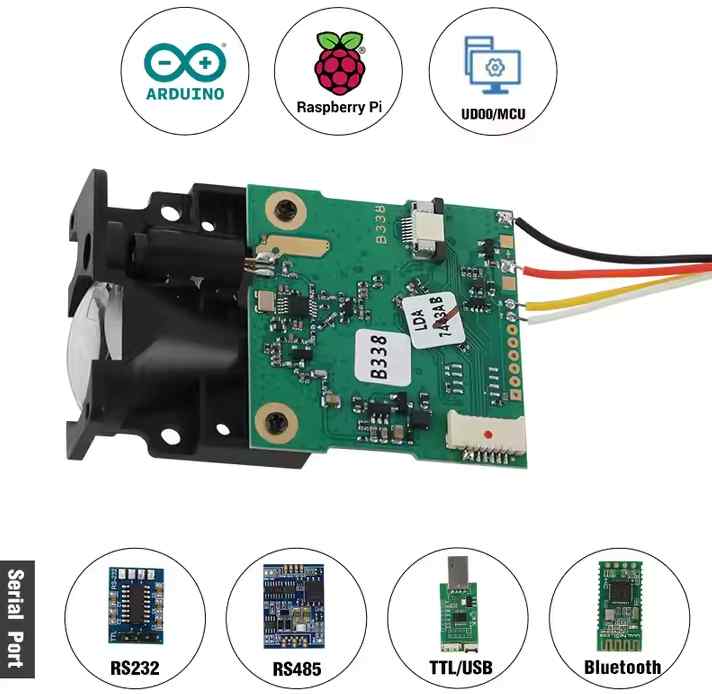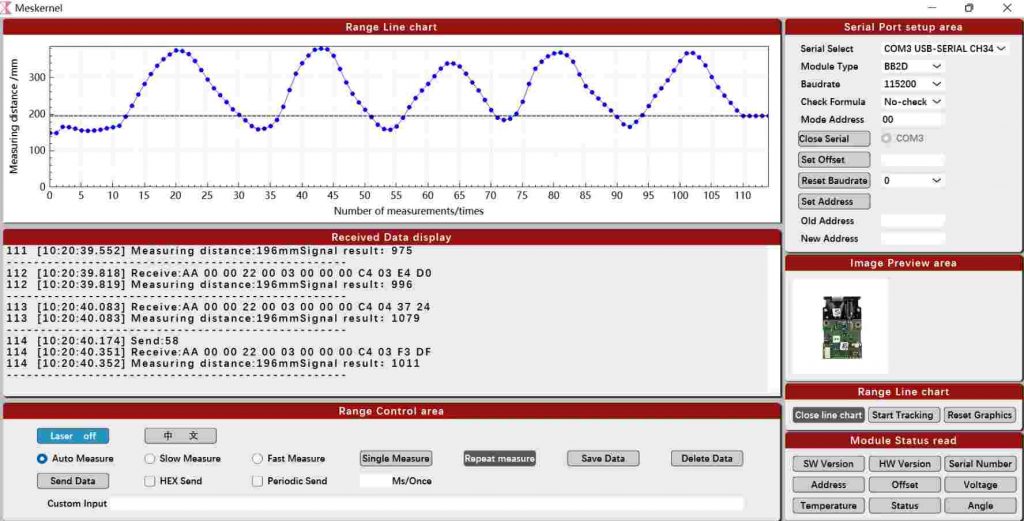Why Laser Measure Distance Matters
In robotics, drones, and industrial automation, laser measure distance technology is becoming essential. Unlike ultrasonic or infrared sensors, laser modules deliver faster response and higher accuracy, making them the backbone of modern precision systems. Whether you are stabilizing a drone’s altitude, monitoring liquid levels, or performing industrial surveying, accurate distance measurement determines the overall reliability of your project.
Limitations of Consumer ToF Sensors
Many consumer-grade ToF (Time-of-Flight) sensors provide only centimeter-level accuracy. While this may be enough for simple obstacle detection, it often fails in demanding applications where even small errors can cause system instability or safety issues. This is where professional modules like the Meskernel LDJ series stand out.
Why Choose Meskernel LDJ Modules for Laser Measure Distance
According to the official Meskernel LDJ User Manual, the LDJ series uses indirect Time-of-Flight (iToF, phase-difference) technology to achieve millimeter-level resolution and excellent stability.
Key Specifications
- Measurement resolution: 1 mm
- Typical accuracy: ±(3 mm + D × 1/10000), where D is distance in millimeters
- Measurement range: 0.03 m to 100 m / 150 m / 200 m depending on model and reflectivity
- Continuous frequency: up to 20 Hz in favorable conditions
- Laser: Class II, wavelength 610–690 nm, <1 mW
- Supply voltage: 2.5–3.6 V (3.3 V recommended)
- Dimensions: 62.9 × 40 × 18 mm
Compared with popular maker-oriented modules such as TF-Luna, the LDJ delivers a clear performance upgrade, enabling laser measure distance at professional-grade precision.
Hardware Overview and Wiring Basics
The modules are designed for easy integration with microcontrollers and single-board computers.

- Core pins: TXD, RXD, VCC, PWREN, GND
- Interface: UART (3.3 V TTL, default)
- Multi-device support: Up to 8 modules per UART bus, expandable to 127 with unique addresses
Example: Wiring to ESP32
- VCC → 3.3 V
- GND → GND
- TXD → ESP32 RX2 (GPIO16)
- RXD → ESP32 TX2 (GPIO17)
- PWREN → GPIO4 (module enable)
Example: Wiring to Raspberry Pi
- Use Pi’s 3.3 V UART pins or USB-TTL adapter
- Cross-connect TXD/RXD and share GND
- Ensure power supply is stable at 3.3 V
With these setups, developers can quickly test laser measure distance in real-world projects.




Communication Protocol in Practice
Meskernel LDJ modules use binary command/response packets with a simple structure:
- Header byte: 0xAA
- Key register: REG_MEA_RESULT (0x0022) holds measurement results (32-bit, mm)
- Control: Enable continuous measurement via command; send ASCII
0x58 (“X”) to stop
Each response also contains a signal quality (SQ) indicator, which helps developers assess reflectivity and environmental conditions.
ESP32 (Arduino) Example
// ESP32 with Meskernel LDJ module
HardwareSerial ModSerial(2);
const int PWREN_PIN = 4;
uint8_t continuousCmd[] = {
0xAA, 0x00, 0x00, 0x20, 0x00, 0x01, 0x00, 0x05, 0x26
};
void setup() {
Serial.begin(115200);
ModSerial.begin(115200, SERIAL_8N1, 16, 17);
pinMode(PWREN_PIN, OUTPUT);
digitalWrite(PWREN_PIN, HIGH);
delay(150);
Serial.println("Meskernel LDJ demo starting...");
ModSerial.write(continuousCmd, sizeof(continuousCmd));
}
uint32_t parseMeasurement(uint8_t *buf, size_t len) {
for (size_t i = 0; i + 9 < len; ++i) {
if (buf[i] == 0xAA && buf[i+3] == 0x22) {
uint32_t m = ((uint32_t)buf[i+6] << 24) | ((uint32_t)buf[i+7] << 16) |
((uint32_t)buf[i+8] << 8) | ((uint32_t)buf[i+9]);
return m;
}
}
return 0xFFFFFFFF;
}
void loop() {
static uint8_t rxBuf[256];
static size_t idx = 0;
while (ModSerial.available()) {
int b = ModSerial.read();
if (idx < sizeof(rxBuf)) rxBuf[idx++] = (uint8_t)b;
uint32_t dist = parseMeasurement(rxBuf, idx);
if (dist != 0xFFFFFFFF) {
Serial.print("Distance (mm): ");
Serial.println(dist);
idx = 0;
}
}
delay(10);
}
This sketch reads and prints measured distances in real time, allowing developers to validate module performance.
Raspberry Pi (Python) Example
import serial
import time
ser = serial.Serial('/dev/ttyUSB0', 115200, timeout=0.2)
continuous_cmd = bytes([0xAA,0x00,0x00,0x20,0x00,0x01,0x00,0x05,0x26])
ser.write(continuous_cmd)
time.sleep(0.1)
buf = bytearray()
while True:
data = ser.read(128)
if data:
buf.extend(data)
for i in range(len(buf)-9):
if buf[i] == 0xAA and buf[i+3] == 0x22:
val = (buf[i+6]<<24) | (buf[i+7]<<16) | (buf[i+8]<<8) | buf[i+9]
print("Distance: {} mm".format(val))
del buf[:i+10]
break
time.sleep(0.02)
With just a few lines of code, Raspberry Pi users can test laser measure distance output and log values for analysis.
Testing and Accuracy Validation
For reliable results, follow a structured testing process:
- Place a high-reflectivity target at known distances (0.1 m, 0.5 m, 1 m, 5 m, 10 m, etc.).
- Collect at least 50 samples at each distance.
- Calculate mean error, standard deviation, and maximum deviation.
- Repeat with different targets and ambient light conditions.
This ensures confidence in the laser measure distance performance under various scenarios.
Best Practices for Integration
To maximize performance, we recommend:
- Use low-speed mode when accuracy is critical.
- Apply offset calibration if required.
- Provide a clean 3.3 V power supply with decoupling capacitors.
- Keep the optical lens clean and mount the module securely.
Example Applications
The LDJ series enables laser measure distance in fields where precision is critical:
- Drone altitude hold and precision landing
- Robotic obstacle avoidance with millimeter accuracy
- Liquid level detection in tanks and reservoirs
- Automated warehouse systems for AGV navigation
- DIY scanning rigs for mapping and surveying
Frequently Asked Questions (FAQ)
Q1: What is the maximum distance of the Meskernel LDJ modules?
Depending on the model, they can measure up to 100 m, 150 m, or 200 m under good reflectivity.
Q2: Can I use LDJ modules outdoors in sunlight?
Yes. The signal quality (SQ) indicator helps ensure reliable readings, even under varying ambient light.
Q3: How many modules can I connect at once?
Up to 8 modules can share a UART bus; multi-segment setups allow up to 127 modules.
Q4: What makes LDJ different from cheaper ToF sensors?
The LDJ series achieves millimeter resolution, far exceeding the centimeter-level accuracy of consumer-grade sensors.
By integrating Meskernel LDJ modules, developers can achieve laser measure distance with unmatched accuracy and stability. With easy hardware connections, open protocols, and proven test methods, the LDJ series is ready to power advanced robotics, drones, and industrial automation systems.
👉 Download the official user manual and software tools to get started, or contact us for product inquiries and support.